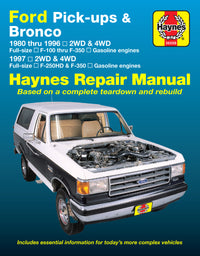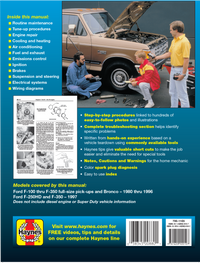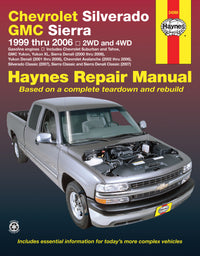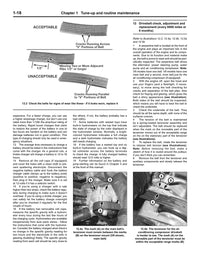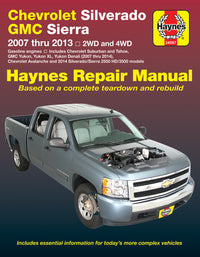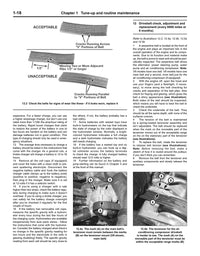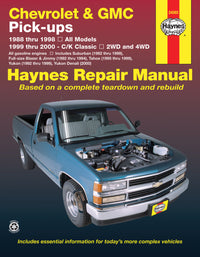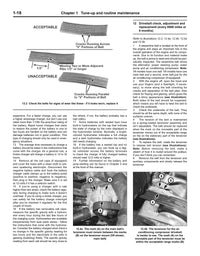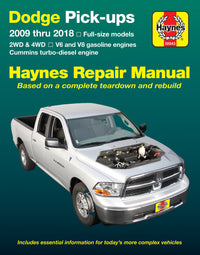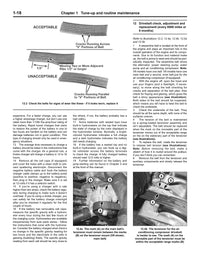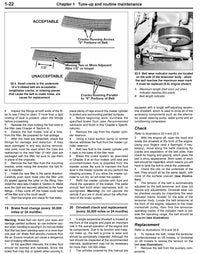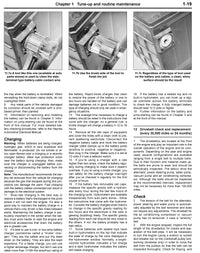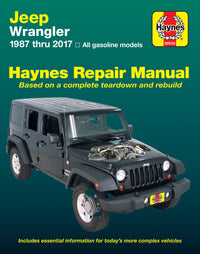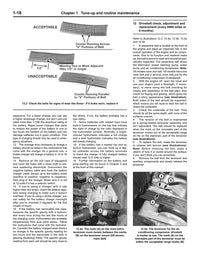Modern vehicles need much less maintenance than the vehicles of 25 years ago, but they still need fluid changes, inspections, and adjustments. You no longer need to do a tune-up every six months or change the oil every three months, but regular service and check-ups are still essential to your vehicle’s longevity. What follows is our quick reference guide for the modern Jeep Wrangler YJ (1987-95), TJ (1996-2006), and JK (2007-2017) with various gasoline 4 cylinder, 6 cylinder and V6 engines, taken directly from Haynes manual 50030.
Most of these recommended routine maintenance tasks you can do yourself at home for practically no money, as long as you have a few simple tools and the time to invest. If you need more guidance, or even step by step instructions and a video demonstration, get the online manual, or our traditional printed manual.

Maintenance Schedule
The following intervals are based on the assumption that you will be doing the service work yourself, as opposed to paying to have the work done. These are our recommended minimum maintenance intervals for vehicles that are driven daily, and in many cases are shorter than the factory’s recommendations. Because frequent maintenance enhances the efficiency, performance and resale value of your Jeep, we encourage you to follow our schedule. If you drive in dusty areas, tow a trailer, idle or drive at low speeds for extended periods, or drive for short periods (less than four miles at a time) in below freezing temperatures, even smaller intervals are recommended.
When the vehicle is new, follow the maintenance schedule to the letter, record it in your owner’s manual and keep all receipts to protect the warranty and resale value. In many cases the initial maintenance check is done by the dealer at no cost (check with the service department when you buy the truck for more information).
Every 250 miles or weekly, whichever comes first
- Check the engine oil level
- Check the engine coolant level
- Check the windshield washer fluid level
- Check the brake and clutch fluid levels
- Check the tires and tire pressures
Every 3000 miles or 3 months, whichever comes first
All items listed above plus:
- Check the automatic transmission fluid level
- Check the power steering fluid level
- Check and service the battery
- Check the cooling system
- Inspect and replace, if necessary, all underhood hoses
- Inspect and replace, if necessary, the windshield wiper blades
Every 7500 miles or 12 months, whichever comes first
All items listed above plus:
- Change the engine oil and filter*
- Lubricate the chassis components
- Inspect the suspension and steering components*
- Inspect the exhaust system*
- Check the manual transmission lubricant level*
- Check the differential lubricant level*
- Check the transfer case lubricant level
- Rotate the tires
- Check the brakes*
- Inspect the fuel system
- Check the carburetor choke operation
- Check the carburetor/ throttle body mounting nut torque
- Check the throttle linkage
- Check the thermostatically-controlled air cleaner
- Check the engine drivebelts
- Check the seatbelts
- Check the starter safety switch
- Check the spare tire and jack
Every 30,000 miles or 24 months, whichever comes first
All items listed above plus:
- Check and adjust, if necessary, the engine idle speed
- Replace the fuel filter (1987 through 1995 models only)
- Replace the air and PCV filters
- Check and adjust, if necessary, the ignition timing
- Change the automatic transmission fluid**
- Change the manual transmission lubricant
- Change the differential lubricant
- Change the transfer case lubricant
- Service the cooling system (drain, flush and refill)
- Inspect and replace, if necessary, the PCV valve
- Inspect the evaporative emissions control system
- Replace the spark plugs
- Inspect the spark plug wires, distributor cap and rotor (2003 and earlier models)
Every 72,000 miles or 72 months, whichever comes first
All items listed above plus:
- Replace the oxygen sensor and emissions timer (49-state models)
- Inspect and replace, if necessary, all underhood hoses
* This item is affected by “severe” operating conditions as described below. If your vehicle is operated under severe conditions, perform these maintenance tasks at 3000 miles/3 month intervals. Severe conditions include the following:
- Operating in mostly dusty areas (dirt roads, or off-road)
- Idling for extended periods and/or low speed operation
- Mostly short trips (less than 4 miles) when outside temperatures remain below freezing
** If operated under one or more of the following conditions, change the automatic transmission fluid every 12,000 miles.
- In heavy city traffic where the outside temperature is regularly above 90-degrees F (32-degrees C)
- In hilly or mountainous terrain
- Frequent trailer towing
- Frequent off road use

